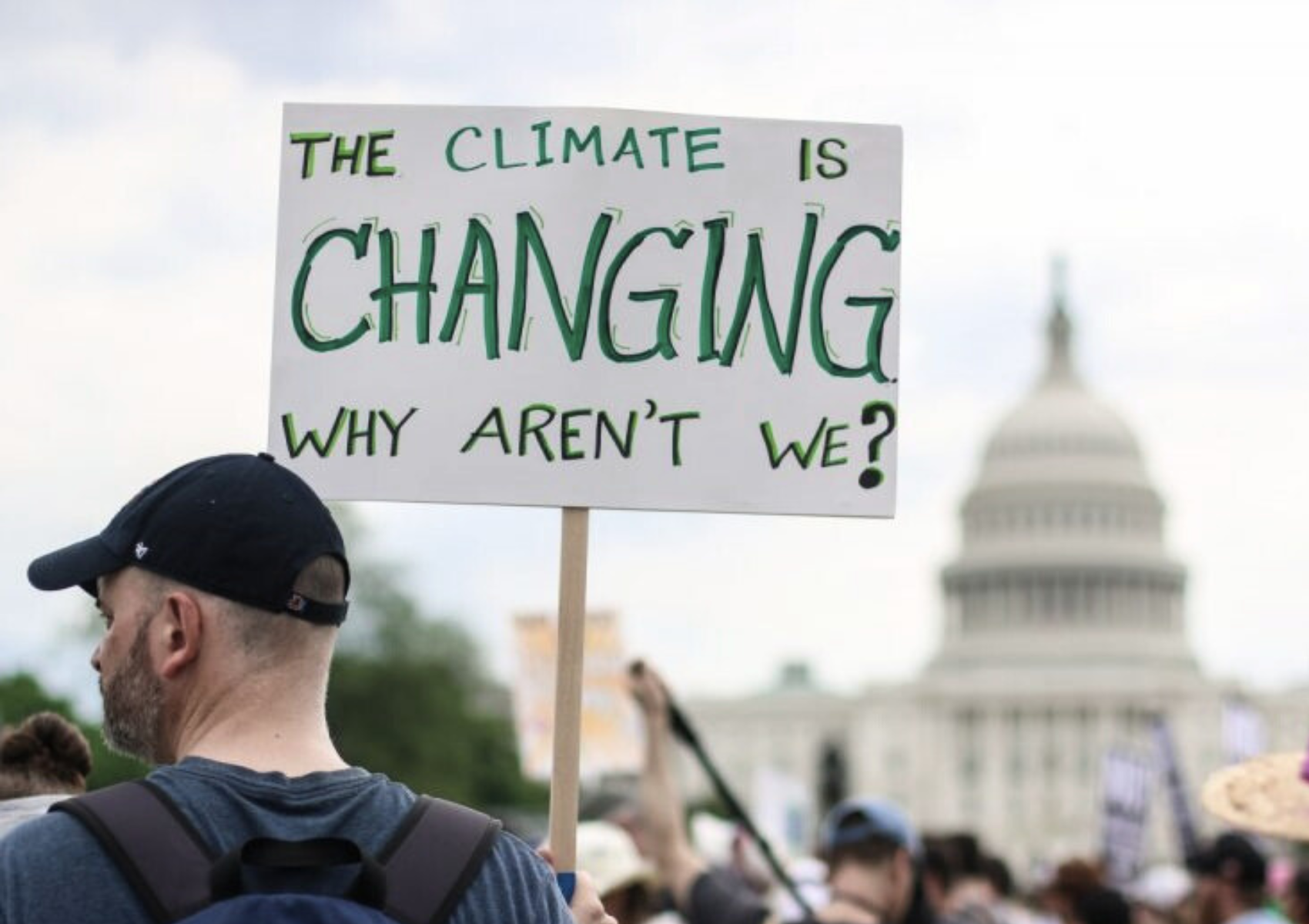
Systemic Change: Taking Action To Create a Better Future
About the Author
SHRUTI MACHIRAJU graduated from Texas A&M University with a B.S. in Bioenvironmental Sciences in 2022. She is the former Co-Chair of the Congressional and Corporate Outreach Team at Change the Chamber. She’s met with several legislative offices to discuss environmental regulations and policies, and she has helped build relationships with various environmental organizations. She has also presented about environmental laws, policies, and regulations to university faculty. She is interested in environmental law and policy, environmental justice, and sustainability.
Supporting Authors: Erin McClain, Manushi Sharma & Tony Passino


Overview
The world is complex, and so are the biggest problems that we experience. In the Allyship module, you learned how some of the biggest problems we experience, whether they be climate change or systemic racism, are connected in unexpected ways. In this module, we provide you with a path to navigate this complexity. As a changemaker, your goal is to understand and try to change the system itself so that your positive impact on the world can be felt widely in your lifetime and for generations to come.
Key Learnings
Upon completion of this module, you will have:
Learned how systems overlap and interact with one another.
Analyzed different strategies for creating larger systemic change.
Identified strategies that may influence your approach as a changemaker.
Required Content (1.5 hour estimated commitment)
To complete this module, you must:
Read the entire module.
Watch the following videos.
Develop and submit your commitments.
Supplemental Content
The following articles / videos / resources are recommended but not required:


Introduction to Systemic Change
So you might be wondering, what is systemic change and why is it so important? To answer this question you need to think big. The world as we know it is a type of system that is operating within an even larger system: the universe. OK, maybe not that big. The point here is that the functioning of our planet is dependent on numerous elements that interact with one another in unique ways and we need to change systems to make sustainable development viable.
In the introduction to climate change presentation within the first module, you learned about the importance of keeping our planet healthy and understanding the life sustaining gifts we receive every day from the planet.. Damage one key part of the ecosystems we depend upon for our lives and you run the risk of creating a chain reaction that leads toward destruction. This is the nature of systems; change one element and you have the potential to change the entire system. As a Changemaker, you can use this in your favor to promote positive, lasting change.
Before moving forward with this module, it is important to know how we define the following terms:
System: A collection of different elements that interact with one another to achieve some goal.
System example: Your body is a system. From the smallest cells to the largest organs, each of these elements interact with one another to make you a unique individual. In the case of your body, the goal of the overall system is survival. There can be multiple (and competing) goals within any given system.
Systems thinking: Oftentimes considered to be a way of looking at the world. It is an approach that emphasizes a systems perspective. It comes to life in our individual thinking and can be used to guide decision making.
Systemic change: The act of understanding and intervening in systems to promote positive change across the system and oftentimes beyond the system.
Leverage point: An area of contact with the system where a small shift can lead to widespread effects. For more on leverage points, you can read the optional article by Donella Meadows who is one of the founders of systems thinking.
Leverage point example: One of the most powerful leverage points is to change the underlying goals of a system. Imagine an economic system that prioritizes individual well being over profit. Without the need for ever expanding profit margins, we would be better able to limit the negative consequences associated with overconsumption and unchecked growth.
Watch the following video by Adrian Röbke that discusses the interrelatedness of systems, and how to recognize it to create systemic change. After watching the video we encourage you to think about the systems that you interact with each day. Systems are all around us. If we can recognize them, we can begin the work needed to change them.

Our society is made up of several complex systems that overlap with one another, and sometimes contradict each other. That’s not unexpected, and it’s part of the nature of society. Most of what you’ll need to do to create lasting, meaningful change will be to transform systems already in place. To do this, you need to understand how systems interact, and where the leverage points are to create system wide changes.
What you’re here to do is identify how these systems impact you and your goals as a changemaker. If you’re new to seeing and understanding things like the systems of government, social movements, advances in science and technology, and economics, it can seem overwhelming. These systems can be daunting, but don’t let that feeling stop you from moving forward. The good news is that systems can be understood enough to identify leverage points for change, systems are always evolving, and you can impact the trajectory of these systems through action.
Working toward environmental change will require you to know more about the interrelated systems that impact it. Think of these systems not as huge and unknowable things to fight against, but as pieces of a whole that make up the society you know. Remember, understanding them allows you to be active in changing them.
SYSTEMS MAPPING
Systems are messy, layered, and complex. There is no one-size-fits-all solution. You should piece together a jigsaw of solutions that can adapt and evolve as you learn more about what works and what doesn't. Systems change also challenges the conventional linear approaches by recognizing that complex systems often exhibit unexpected behaviors and interconnectedness, requiring dynamic and adaptive strategies.
To amplify your work as a changemaker it is important that you have a holistic understanding of the system you are trying to change. Watch the following video that provides an overview of how you can use systems mapping as a tool for systemic change. For a step by step guide on how to do systems mapping, you can read through the supplemental resource here.
HAVE A PLAN, BUT LEAVE ROOM FOR UNCERTAINTY
System interventions can have ripple effects that are difficult to predict. Within systems change, ambiguity and uncertainty are guiding forces that you have to learn how to navigate as a changemaker. With this in mind, flexibility, persistence and resilience become essential qualities in navigating change.
As a Changemaker, you want to focus on the root causes rather than surface-level symptoms. When the root causes are too difficult to tackle, it can be valuable to take what is called the 'lowest hanging fruit approach'. For example: If your vision of the future includes several of the Sustainable Development Goals, it might be best to start working on the goal that you are most familiar with. After you are successful with a smaller initiative, you can use this as evidence to tackle a larger problem.
Being able to accurately understand the problem you are trying to address is important because when we create solutions for a problem that is not well-defined or understood, we can actually create solutions that do not address the real issue at hand. Even worse, we can create solutions that actually make the problem worse. You might be thinking...what does this mean for a complex topic like climate change that has many connected problems? How can we be expected to understand all of these complex problems? How do we create solutions? Sound overwhelming? You’re not alone.
When we work together, we multiply our efforts in unexpected ways. When it comes to tackling a complex problem, working together can help you develop a holistic understanding of the system you are trying to change. Reach out and look for others who are trying to solve the problem you are passionate about. Try to see the problem from their point of view. Many experts have materials online; use what exists and make sure that your source is credible. Your understanding of the problem will continue to grow as you develop solutions. Be open and adaptable as new information may change your entire approach.


Strategic Approaches for Creating Systems Change
Once you have a better understanding of the problem, you can begin to think about how you will create a brighter future. Strategy is an important element of effective changemaking, and it is essential for bringing about systemic change. Think of strategy as if it were your approach. It is how you accomplish the goal. According to Debra Rowe, editor of the encyclopedia Achieving Sustainability, within the context of systems change, the following are three strategic approaches.
You can work within the existing system of organizations and economic structure to create change.
You can choose to work from outside the system, agitating for change.
You can also work to build alternatives that form visible precedents, where enough people join the more sustainable way of life to make it the new societal norm and marginalize the old ineffective structures.
As you progress in your journey as a changemaker, you will develop a better understanding of which strategies you gravitate towards. You may use one in a given situation, and you may take a completely different approach in another situation. You may also use all three strategies simultaneously to help build the movement for a sustainable future. All three approaches are valuable.
I. BEING AN INTRAPRENEUR: WORKING “WITHIN THE SYSTEM” TO CREATE CHANGE
An intrapreneur is a change agent within an organization or larger system working to create systems change. An intrapreneur looks at where changes can be made and creates collaborations with allies to make it happen. When it comes to being an intrapreneur, it is important to "know” your system: the variety of views held by different subgroups, how those views are imparted on you (what do they want you to think), who is involved, who has power (either informal power through relationships or formal power through hierarchies and societal structures) and what are the key motivations and issues. Often you can create systems change within an organization (e.g. a university, a business, a city’s government). As you build change from within, look for allies with similar viewpoints to work with (or to just have discussions with) as there is more power together and you can share information. At Emory University, what started as Friday brown bag lunch discussions turned into a robust sustainability program that made changes across the campus and beyond.
If you choose as one of your strategies to build a multi-stakeholder coalition across many organizations, you can create even broader change. Building an effective coalition (see the previous module) requires including representation from key stakeholder groups. This diagram helps to identify the possible stakeholders for a multi-sectoral coalition.(This diagram was designed to address workforce development for an inclusive clean energy transition but can be used to help identify stakeholders for a variety of environmental issues.)
Engage with stakeholders to ensure that those closest to the problem have a say in the problem identification and solution generation process, including but not limited to neighborhood and environmental justice organizations. It is useful to collaborate across fields, sectors, and groups to address complex problems related to the environment to align and coordinate solutions and to create larger changes. For example, creating an adaptation plan to address severe weather events from climate change should be coordinated through a coalition that includes city government, health organizations and large organizations such as businesses and local universities. A coalition requires a good team to facilitate the relationships, build the coalition and move forward to joint action. This can be done with professional staff or with dedicated volunteers.
II. WORKING FROM OUTSIDE THE SYSTEM: AGITATING FOR CHANGE
Sometimes, it can be valuable to take a step back from the system in which you find yourself to see how you might work from the outside to promote change. For example, you may be working to change the organization you work for (a type of system) and you may be struggling to promote change from within. In this case, your change efforts can be amplified by connecting with external organizations that are aligned with your efforts for internal change. External organizations that are well respected can help motivate the organization you work for to change. Building on this idea, here are a few key tips that may be useful when advocating for change from the outside.
Look for organizations that are aligned with your change efforts and connect with them to see if they would be interested in working together or to learn from them and amplify their efforts
They may be able to provide resources, data or other information that can support your specific efforts. Some of the many organizations that pressure for change for sustainable development (e.g. clean energy, an inclusive economy and other related issues) from outside of the typical business and governmental approaches are Fossil-Free Finance | Sierra Club, the Democracy Collaborative, Greenpeace, and Extinction Rebellion.
Start your own group that focuses on your changemaking initiative.
You might consider starting small and building a coalition of support that includes key players that can influence your initiative. (If these actions might put your job and your livelihood at risk, you might focus on challenging other organizations in your efforts to pressure change.)
Explore different fields, sectors and groups different from your own who may have done similar work.
Ideas and tactics from different initiatives, movements and projects can be utilized in new and creative ways. Rather than reinventing the wheel, consider how you might use what has already been proven to be successful. For example, tobacco prevention work has developed some powerful strategies, campaigns and initiatives that have helped to drive down tobacco usage rates in the US. How might you adapt these ideas to your specific efforts?
III. CREATING ALTERNATIVES: BUILDING SUSTAINABLE SYSTEMS
Systems are hard to change. Some are nearly impossible. Rather than changing the existing system, create a new set of systems. Think about how you might create an alternative system that can be designed to demonstrate and promote human and planetary flourishing.
Examples of this include alternative food and agricultural networks that seek to change the way we eat through a system that operates outside our globalized food system. These alternative systems can spread and they can impact other systems as they grow in popularity. Never underestimate the power of creating radically new ways of living that are aligned with the natural world. Another example is the networks of ecovillages and intentional communities.


Engaging in Policy and Systems Change
Once you have an understanding of where you want to go and how you want to get there, creating a plan can help to bring about systemic change. There are several methods you can use to create systemic change. Here is a basic outline of how to make change regardless of what strategies you use. Keep these ideas from the Clean Energy Economy and Workforce Preparation Toolkit by Debra Rowe in mind when you develop your commitments.
Find where to put your efforts and impact.
Look for leverage points for systems change.
This might be the immediate opportunities that have a high likelihood of creating a ripple effect across the system. For example, a small change to an existing policy could have a disproportionately large impact on a local ecosystem or on a large population.
Try to understand the formal and informal power structures you are trying to change.
Understanding how power works is important regardless of the scale (local/state/national/international) because power is embedded in everything and you can connect with people that have formal or informal power to create change
Try to find champions within the system who are aligned with what you want to change and understand their motivations. Call an organization and ask whoever answers which person is most interested in environmental issues in the organization. Speak to that person to gain valuable insights into where the leverage points are for systemic change.
Take it a step further and build relationships with these champions.
These champions oftentimes hold a special type of power that makes them a credible source. Attaching yourself to them can be a smart move.
Frame your own message and follow groups that speak to the overall direction you, as an individual, want to move in.
Social media is a good place to start for this.
Many organizations also release newsletters or have email lists and webinars that frequently share out important information.
Build coalitions of support.
These can be with individuals or whole organizations.
Don’t leave key votes to chance. Count your support and build it outside of meetings and ask people to show up and support during the meeting (if there are meetings) to build the atmosphere and the decisions needed for change.
Be realistic: Don’t try to be the expert before you start. Understand the extent of your own capabilities and where you can make an actual change.
This comes through self-reflection. If you find that you are not the expert on a topic, reach out to and build a relationship with someone who is.
Evaluate the outcomes.
Measuring the outcomes of your work is essential for communicating your progress and deciding what you want to do next.
Don’t expect to be successful all the time. Be involved in more than one strategy so if one doesn’t work, you can still work on the others. Don’t fear failure. Not succeeding at first is an opportunity to learn and keep trying. Recognize that change can take time. Be persistent and celebrate each successful step in the process.
You don’t have to target the entire system to create meaningful change. Change to one part can have dramatic impacts on other parts! The work you do can spark further innovation, and the connections you make along the way with other people and organizations can help cultivate ideas and initiatives into a stronger network.
Portfolio Entry: Changemaker Commitments
Working on yourself is a powerful first step that can lead to systemic change. To work towards your vision of the future and create systemic change, it is important to think about the person you need to become. What skills do you want to develop? What organizations can you become allies with? This activity will get you to start thinking about questions like these as you take the next step in your changemaker journey.
FORMAT
Your commitments should be written and saved in a place where you will see them every day. If you are using a Word document, you can save them as your screensaver. If you are writing them on paper, use sticky notes and place them in a visible place.
Whatever format you use, tell us where you will keep the commitments and share a photo/screenshot of your commitments.
INSTRUCTIONS
Answer the following questions and submit your commitments to the course facilitator when submitting the evaluation for this module.
Use the answers to the questions below to create 1-3 commitments that you will actively work on this year. (Example: I will reach out to 3 environmental justice organizations to see if there are any volunteer opportunities within the next year that I can get involved with.) Feel free to get creative with your commitments. Most importantly, make a promise to yourself that you will work to achieve your commitments.
QUESTIONS
What issues do you need/want to learn more about?
What skills do you need/want to develop?
What organizations will help you achieve your goals and how will you get in touch with them?
How will you care for yourself as an environmental changemaker? (We will also help you answer this in an upcoming module.)
It can be valuable to share your commitments with others. When you share your commitments, you create a sense of accountability. We encourage you to share them with your friends and family.
It is also vital that you remain open to change when it comes to your commitments. It is important that you are able to take advantage of new opportunities because doing so may allow you to make a lasting impact. In this light, you may want to alter your commitments as you continue your journey as a changemaker.





